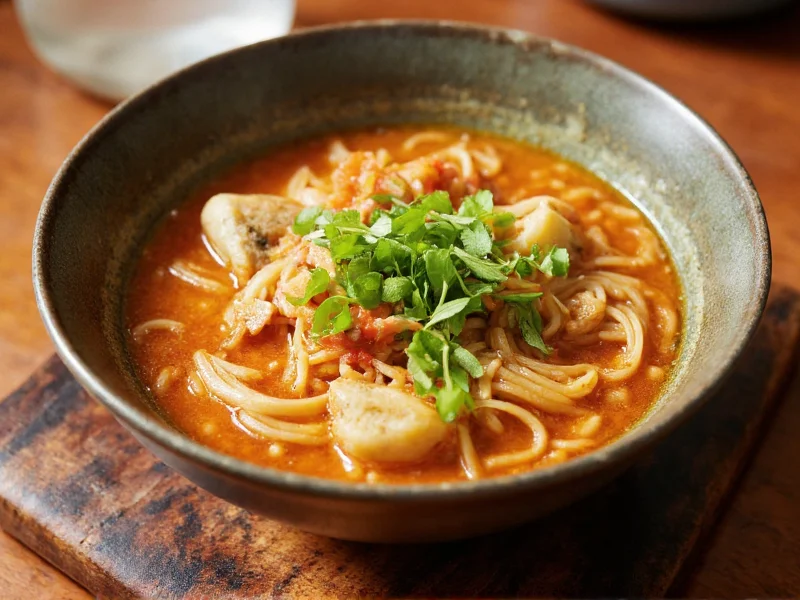When you order wanton mee soup at a traditional Malaysian hawker stall, you're getting more than just a meal—you're experiencing a culinary tradition that blends Chinese noodle craftsmanship with local Malay and Peranakan influences. The dish's distinctive character comes from its carefully balanced components, each contributing to the overall sensory experience.
What Sets Wanton Mee Soup Apart From Other Noodle Dishes
Many people confuse wanton mee soup with Singapore's dry wanton mee or basic wonton soup. The critical distinction lies in the preparation method and broth quality. Authentic Malaysian wanton mee soup features a clear, golden-hued broth simmered for hours with pork bones, dried flounder, and aromatic spices. This differs significantly from the thicker, darker broths found in Chinese wonton soup or the sauce-based Singaporean version.
The "mee" in wanton mee soup specifically refers to the springy yellow wheat noodles that hold their texture perfectly in the hot broth. These egg noodles provide the ideal foundation for the delicate wontons and tender char siu that complete the dish.
Essential Components of Authentic Wanton Mee Soup
Three elements define a proper wanton mee soup experience:
- The Broth – A clear, flavorful pork-based stock that's light yet deeply savory, often enhanced with dried seafood for umami
- The Wontons – Small, delicate dumplings filled with a mixture of minced pork and shrimp, wrapped in thin wonton skins
- The Noodles – Fresh yellow wheat noodles that maintain their springiness when submerged in broth
| Component | Authentic Characteristics | Common Mistakes |
|---|---|---|
| Broth | Clear, golden color; subtle pork flavor with umami depth; never cloudy | Using artificial flavorings; over-seasoning; cloudy appearance |
| Wontons | Small (1-1.5 inch); thin wrapper; pork-shrimp filling; pleated closure | Oversized; thick wrapper; only pork filling; poor sealing |
| Noodles | Yellow wheat noodles; springy texture; properly cooked al dente | Overcooked; using wrong noodle type; mushy texture |
Regional Variations Across Malaysia
While wanton mee soup maintains its core identity throughout Malaysia, regional interpretations add fascinating diversity to this beloved dish:
- Kuala Lumpur style – Features a slightly richer broth with more pronounced dried seafood notes, often served with roasted pork slices
- Penang version – Incorporates subtle tanginess from vinegar in the broth, with thinner noodles and smaller wontons
- Selangor interpretation – Typically includes additional toppings like fish cake slices and a hint of white pepper for gentle heat
These regional differences reflect Malaysia's diverse culinary landscape while maintaining the essential character of wanton mee soup. When searching for traditional wanton mee soup near me, understanding these variations helps identify authentic preparations.
Creating Homemade Wanton Mee Soup: Key Techniques
Recreating authentic wanton mee soup at home requires attention to specific techniques that distinguish it from ordinary noodle soups. The broth preparation represents the most critical element for achieving restaurant-quality results.
For the broth, start with pork neck bones and trotters, simmering them for at least 4 hours with dried flounder, ginger, and scallions. Skim impurities regularly to maintain clarity. The wonton filling should combine ground pork with finely chopped shrimp, bamboo shoots, and a touch of sesame oil – never using excessive seasoning that would overpower the delicate flavors.
When assembling wanton mee soup, always add the noodles to the hot broth rather than pre-cooking them separately. This allows the noodles to absorb the broth's flavor while maintaining their ideal texture. The proper wanton mee soup serving temperature should be piping hot but not boiling, preserving the delicate balance of flavors.
Avoiding Common Preparation Mistakes
Many home cooks struggle with wanton mee soup preparation due to these frequent errors:
- Cloudy broth – Caused by boiling too vigorously or not skimming impurities; maintain a gentle simmer
- Soggy wontons – Result from overcooking; add wontons to broth just before serving
- Mushy noodles – Occurs when noodles sit too long in broth; cook noodles separately and add to hot broth just before serving
- Overpowering flavors – Authentic wanton mee soup features subtle, balanced tastes; avoid excessive seasoning
Mastering the art of wanton mee soup requires patience and attention to detail. The difference between ordinary and exceptional wanton mee soup often comes down to broth clarity and noodle texture – two elements that separate authentic preparations from imitations.
Experiencing Wanton Mee Soup Culture
In Malaysia, wanton mee soup transcends mere sustenance – it represents a shared cultural experience. The best wanton mee soup establishments often operate from pre-dawn until early afternoon, as the broth requires hours of careful preparation. Many renowned stalls have been run by the same families for generations, passing down closely guarded broth recipes.
When enjoying wanton mee soup at a traditional hawker center, notice how the server assembles each bowl with precision: first the noodles, then the broth poured tableside, followed by carefully arranged toppings. This ritual reflects the cultural importance placed on proper wanton mee soup presentation and service.











 浙公网安备
33010002000092号
浙公网安备
33010002000092号 浙B2-20120091-4
浙B2-20120091-4